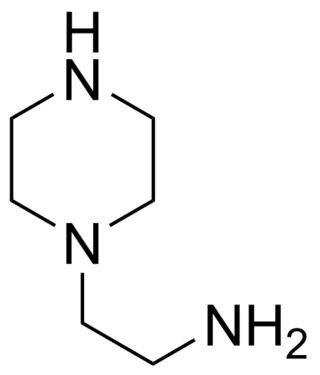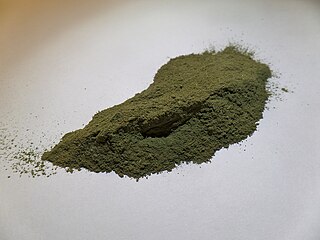
Lithium citrate (Li3C6H5O7) is a lithium salt of citric acid that is used as a mood stabilizer in psychiatric treatment of manic states and bipolar disorder. There is extensive pharmacology of lithium, the active component of this salt.

Potassium tartrate, dipotassium tartrate or argol has formula K2C4H4O6. It is the potassium salt of tartaric acid. It is often confused with potassium bitartrate, also known as cream of tartar. As a food additive, it shares the E number E336 with potassium bitartrate.

Trisodium citrate has the chemical formula of Na3C6H5O7. It is sometimes referred to simply as "sodium citrate", though sodium citrate can refer to any of the three sodium salts of citric acid. It possesses a saline, mildly tart flavor, and is a mild alkali.

Disodium guanylate, also known as sodium 5'-guanylate and disodium 5'-guanylate, is a natural sodium salt of the flavor enhancing nucleotide guanosine monophosphate (GMP). Disodium guanylate is a food additive with the E number E627. It is commonly used in conjunction with glutamic acid.
Glucono-delta-lactone (GDL), also known as gluconolactone, is an organic compound with the formula (HOCH)3(HOCH2CH)CO2. A colorless solid, it is an oxidized derivative of glucose.

Ponceau 6R, or Crystal ponceau 6R, Crystal scarlet, Brilliant crystal scarlet 6R, Acid Red 44, or C.I. 16250, is a red azo dye. It is soluble in water and slightly soluble in ethanol. It was used as a food dye, formerly having E number E126. It is also used in histology, for staining fibrin with the MSB Trichrome stain. It usually comes as disodium salt.

Sodium fumarate, also called disodium fumarate, is a compound with the molecular formula Na2C4H2O4. It is the sodium salt of fumaric acid, used as an acidity regulator in processed foods. Sodium fumarate and fumaric acid are sometimes used as terminal electron acceptors in the cultivation of certain anaerobic microorganisms. It appears as an odourless, white, crystalline powder and is soluble in water.

Ammonium ferric citrate (also known as ferric ammonium citrate or ammoniacal ferrous citrate) has the formula (NH4)5[Fe(C6H4O7)2]. A distinguishing feature of this compound is that it is very soluble in water, in contrast to ferric citrate which is not very soluble.

Monosodium citrate, more correctly, sodium dihydrogen citrate (Latin: natrium citricum acidulatum), is an acid salt of citric acid. Disodium citrate and trisodium citrate are also known. It can be prepared by partial neutralisation of citric acid with an aqueous solution of sodium bicarbonate or carbonate. It has a slightly acidic taste.

Dicalcium citrate is a compound with formula C6H6Ca2O7. It is a calcium acid salt of citric acid.

Aminoethylpiperazine (AEP) is a derivative of piperazine. This ethyleneamine contains three nitrogen atoms; one primary, one secondary and one tertiary. It is a corrosive organic liquid and can cause second or third degree burns. Aminoethylpiperazine can also cause pulmonary edema as a result of inhalation. It is REACH and TSCA registered.

Deptropine (Brontina) also known as dibenzheptropine, is an antihistamine with anticholinergic properties acting at the H1 receptor. It is usually marketed as the citrate salt.
Sodium citrate may refer to any of the sodium salts of citric acid :

In chemistry, methanetetracarboxylate is a tetravalent anion with formula C5O4−8 or C(−CO−2)4. It has four carboxylate groups attached to a central carbon atom; so it has the same carbon backbone as neopentane. It is an oxocarbon anion, that is, consists only of carbon and oxygen.

Ferrous citrate, also known as iron(II) citrate or iron(2+) citrate, describes coordination complexes containing citrate anions with Fe2+ formed in aqueous solution. Although a number of complexes are possible (or even likely), only one complex has been crystallized. That complex is the coordination polymer with the formula [Fe(H2O)6]2+{[Fe(C6H5O7)(H2O)]−}2.2H2O, where C6H5O73- is HOC(CH2CO2−)2(CO2−, i.e., the triple conjugate base of citric acid wherein the three carboxylic acid groups are ionized. Ferrous citrates are all paramagnetic, reflecting the weak crystal field of the carboxylate ligands.

Comparison of psychoactive alcohols in alcoholic drinks.
Alkali citrate is an inhibitor of kidney stones. It is used to increase urine citrate levels - this prevents calcium oxalate stones by binding to calcium and inhibiting its binding to oxalate. It is also used to increase urine pH - this prevents uric acid stones and cystine stones.















